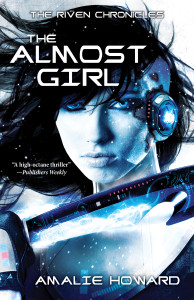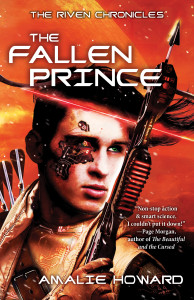“Science Fiction and Science Fact: World-building in The Riven Chronicles”
According to the laws of physics, time travel and inter-dimensional travel are both possible. Having been a science fiction fan for most of my life (Star Wars, Dune, Aliens, and The Fifth Element all grace my top 10 movie list), when I wrote The Riven Chronicles, I knew the world-building and the concept of jumping between universes, had to be complex but relatable, especially for a young adult market. As a fiction writer, any world has to have rules, and those rules have to be consistent or the world falls apart. So step one was definitely research.
I really disliked physics in high school. Disliked is probably an underestimation—I loathed it. During class, I took excessively long bathroom breaks. At home, I agonized over pages of homework I could barely understand. And yet, when I was researching worm holes and parallel universes for The Almost Girl, the first book in my series, I found myself completely fascinated by the laws of physics—a nightmare realm that had instigated far more than its fair share of cold sweats during my teen years. I became sucked into a deliciously dark underworld of sub-quantum mechanics, astrophysics, advanced robotics, nanotechnology, and claytronics.
Building off of Albert Einstein’s space and time theories, physicists throughout history have been hell-bent on reverse engineering the universe and explaining it at its most basic level—discovering the so-called Theory of Everything. Who knew that Hugh Everett’s “Many-Worlds Theory” was an interpretation of quantum mechanics where every possible outcome could happen causing multiple universes (though we wouldn’t be aware of them)? Or that Michio Kaku would come up with String Field Theory demonstrating that gravity could interact between two parallel universes? Or that Stephen Hawking would contend that wormholes exist in a phenomenon called quantum foam? Mind blown. Literally.
Using quantum theory and the microscopic gaps in the universe to allow two distinct points in time and space to connect, I could jump off of Kaku’s string theory, and bolster it with Kip Thorne’s theories of anti-gravitational quantum vacuums to engineer my wormholes, and then tie it into zero-point energy as my “launch” spots to jump between universes (for which I invented the term eversion). Ultimately, I had to take whatever theory I decided to use and make it work for my intended reader. I was looking for complex simplicity—something rooted in the laws of physics, but also accessible to my readers of any strata … meaning making it credible for savvy, erudite sci-fi readers and making it relatable for high-concept teen ones. It was a delicate balance.
Here’s an excerpt from The Almost Girl where I explain this element in my mythology.
A picture forms on the flat-screens in the center of the room. It looks like an hourglass broken up into small squares. “That is a two-dimensional drawing of a traversable wormhole. It’s basically a bridge in space with two different end points. Think of the universe as made up of an infinite number of universes. Some of these universes are coupled by a gravitational field, which means that we can communicate between them.” […] “How it works is a whole other story. We’re talking string theory and sub-quantum mechanics, basically the relationship between space-time, gravity, energy, and matter.”
~ The Almost Girl
As I indicated earlier, I also came up with the concept of “eversion” or “to evert,” which in my mythology means to jump between universes. It’s based on the words trans-inversion (reversal of position) and trans-eversion (turning inside out). I knew I wanted something unique that would work within my framework and wouldn’t be something too generic. I wanted the word to convey an inimitable sense of what it intended—not just something as ordinary as jumping. The word itself had to be a process, one of flipping inside out, and one that conjured thoughts of its own journey.
All in all, writing The Riven Chronicles was an incredible learning experience, especially as it related to science fact and science fiction. I learned that the world of physics is a fascinating one, and that there is so much more to who we are and the universe in which we exist. I learned that something you experience in middle school or high-school could evolve into something extraordinary when approached in a different way—even something as painful as physics (gasp). I learned that science fiction is an awesome space to be in as a writer—it’s a world of infinite possibility with so many opportunities to create. I’m pretty sure that we aren’t the only intelligent life out there, whether that’s in alternate or parallel universes, or in other galaxies. And until that’s proven, for now, I’ll continue to exist in the universes of my own making.
About the Author: Amalie Howard is the award-winning Indie Next author of Alpha Goddess, the Aquarathi series, and the Cruentus Curse series. Her debut novel, Bloodspell, was an Amazon bestseller and a Seventeen Summer Read. Visit her website at www.amaliehoward.com and follow her on Twitter at @AmalieHoward.
About The Almost Girl: Seventeen-year-old Riven comes from a world parallel to Earth, a world that has been ravaged by a devastating android war. As a Legion General, she is the right hand of Prince Cale, the young Prince of Neospes. In her world, she’s had everything: rank, responsibility, and respect. But when Prince Cale sends her away to rescue his long-lost brother, Caden, who has been spirited to modern day Earth, Riven finds herself in uncharted territory.
Armed with the mindset of a soldier and racing against time to bring Caden home, Riven must learn how to blend in as a girl in a realm that is the opposite of all she’s ever known. Will she be able to find the strength to defy her very nature? Or will she become the monstrous soldier she was designed to be?
About The Fallen Prince: When a new enemy threatens her home, Riven’s only hope may be the man who made her a monster.
Riven has fought for a hard-won peace in her world, and has come to shaky terms with who and what she is—a human with cyborg DNA. Now that the rightful ruler of Neospes has been reinstated, Riven is on the hunt for her father in the Otherworld to bring him to justice for his crimes against her people.
But when she receives an unwelcome visit from two former allies, she knows that trouble is brewing once again in Neospes. The army has been decimated and there are precious few left to fight this mysterious new threat.
To muster a first line of defense, her people need help from the one person Riven loathes most: her father. But what he wants in return is her complete surrender. And now Riven must choose: save Neospes or save herself.
This exciting sequel to The Almost Girl combines science, action, and romance in a compelling, hard-to-put-down package.
Thank you to Amalie for the guest post!




